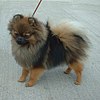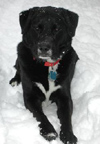A dog's coat is its fur. A dog can be double coated—that is, having both a soft undercoat and a coarser topcoat. Some dog breeds are single-coated—having only one type of coat or the other, more often only the topcoat. The state of the coat is considered an indication of the animal's breeding and health.

Most dogs shed their undercoat each spring and regrow it again as colder weather comes in; this is also referred to as blowing the coat. Many domesticated breeds shed their coat twice a year. In many climates, the topcoat and undercoat might shed continuously in greater and smaller quantities all year.
Some dog breeds' coat is more like human hair than like other animals' fur; for example, the Poodle's coat grows continuously, getting longer and longer, and requires frequent trimming.
Show dogs
The nature and quality of a show dog's coat is an important conformation point in the hobby of dog fancy.
Some considerations in judging the quality of a dog's coat:
- Colour (coat colour other than those allowed in the breed standard results in disqualification)
- Markings (distribution of colour, spots, and patches; for example the spotted coat of a Dalmatian is distinctive, the markings of a terrier vary.)
- Pattern (specific, predictable markings; brindle, for example, is a common pattern.
- Texture of hair (smooth, rough, curly, straight, broken, silky)
- Length of hair
Colours and patterns
Dogs' coats come in a tremendous variety of colours and patterns. Some breeds come in only one or two specific colors, while other breeds can have a wide range of colors, patterns, and shades. Breeds bred strictly for their working ability tend to have more variations than breeds bred primarily for their appearance over a longer time, although some very old breeds also have more limited coat colors.
Words used for coat colours can vary from breed to breed, so a colour that is called red in one breed might be called brown in other breeds.
Colour names
 Brown Chesapeake Bay Retriever | Brown and its variants, including mahogany, midtone brown, gray-brown, blackish brown; the Chesapeake Bay Retriever, whose color "must be as nearly that of its working surroundings as possible", also uses the terms sedge and deadgrass. (Weimaraners are often described as "steel-grey" but they are in fact light brown, the colour of the powder for instant hot chocolate.) | |
 Red Irish Setter |  Dark chocolate Australian Kelpie | Red—reminiscent of reddish woods such as cherry or mahogany—and its variants, including chestnut, , tawny, orange, roan, rust, red-gold, reddish brown, bronze, cinnamon, tan, ruby; also includes liver, a reddish brown somewhat the color of cinnamon or bronze; the breed often determines whether "liver", "chocolate", "brown", or "red" is used to describe the color, as in a liver German Shorthaired Pointer or a chocolate Labrador Retriever. |
 Apricot Poodle |  Dark Golden Retriever | Gold Rich reddish-yellow (orangeish), as in a Golden Retriever, and its variants, including yellow-gold, lion-colored, fawn, apricot, wheaten (pale yellow or fawn, like the color of ripe wheat), tawny, straw, yellow-red, mustard, sandy, honey. |
 Yellow is a common color for mixed-breed dogs |  Yellow Labrador Retriever | Yellow—yellowish-gold tan, as in a yellow Labrador Retriever—and its variants, including blond and lemon. Lemon is a very pale yellow or wheaten color which is not present at birth (the puppies are born white) but gradually becomes apparent, usually during the first six months of life. |
 Cream French Bulldog | Cream: Sometimes it's hard to define the line between pale yellow and cream. Depending on the breed and individual, cream ranges from white through ivory and blond, often occurring with or beneath lemon, yellow, and sable. | |
 Dark orange sable Pomeranian |  Lighter sable Shetland Sheepdogs | Sable: Black-tipped hairs; the background color can be gold to yellow, silver, gray, or tan. The darkness of the coat depends on how much of each hair is black versus the lighter color. |
 Black Newfoundland |  Black Labrador Retriever | Black: Usually pure black but sometimes grizzled, particularly as dogs age and develop white hairs, usually around the muzzle. |
 Kerry Blue Terriers |  Blue merle Australian Shepherd | Blue: Not the rainbow's blue but rather a dark metallic gray, often as a blue merle or speckled (with black). Kerry Blue Terriers, Australian Silky Terriers, Bearded Collies, and Australian Shepherds are among many breeds that come in blue. |
 Silver gray Weimaraner |  Salt and pepper (?) gray Miniature Schnauzer | Gray—sometimes also called blue—and its variants, including pale to dark gray, silver, pepper, grizzle, slate, blue-black gray, black and silver, steel, silver-fawn. |
 White American Eskimo Dog |  White Bichon Frisé | White: Pure white, but distinct from albino dogs. |
Patterns
Patterns, like colours, might be called by different terms for different breeds.
 Liver and tan Australian Kelpie |  Black and Tan Coonhound | Black and tan, liver and tan: Coat has both colors but in clearly defined and separated areas, usually with the darker color on most of the body and tan (reddish variants) underneath and in highlights such as the eyebrows. |
 Black and white Border Collie |  Blenheim (Red-brown and white) Cavalier King Charles Spaniel | Two-color (also called bicolor, Irish spotting, or flashy) coats such as gold and white, liver and white, tan and white, black and white: Usually sharply contrasting colors, usually with the darker color on most of the body and lighter color underneath and in highlights such as the eyebrows, although sometimes one color is in patches, ticks, or other types of markings. Some breeds have special names for the color combinations; for example, Cavalier King Charles Spaniel uses Blenheim for reddish brown (chestnut) and white. Irish Spotted or flashy pattern is symmetrical and includes a white chest, white band around the neck, white belly, and white feet or "boots." This pattern is commonly seen in herding dogs, and Boxers, among others. |
 Black tricolor Entlebucher Mountain Dog |  Red tricolor Miniature Australian Shepherd | Tricolor: Three clearly defined colors, usually either black or red on the dog's upper parts, white underneath, with a tan border between and tan highlights; for example, the Smooth Collie or the Sheltie. Tricolor can also refer to a dog whose coat is patched, usually two colors (such as tan and black) on a white background. |
 Tricolor Beagle | ||
 Blue merle tricolor Australian Shepherd |  Red merle Catahoula Leopard Dogs | Merle: Marbled coat with darker patches and spots of the specified color. Merle is referred to as "Dapple" with Dachshunds. |
 Tuxedo lab mixed-breed dog | Tuxedo: Solid (usually black) with a white patch (shirt front) on the chest, and white on some or all of the feet (spats.) | |
 Harlequin Great Dane | Harlequin: "Torn" patches of black on white. Only the Great Dane exhibits this coat pattern. | |
 Spotted Dalmatian | Spotted | |
 Red patched Borzoi |  Brown and white patched and speckled English Springer Spaniel | Patched |
 Red-speckled Australian Cattle Dog |  Liver-ticked German Shorthaired Pointer | Flecked, ticked, speckled: also called belton in English Setters |
 Orange belton (orange and white speckled) English Setter |  Blue belton (black and white speckled) English Setter |  Blue speckled Australian Cattle Dog |
 Light brindle Great Dane |  Darker brindle and white Boston Terrier | Brindle: A mixture of black with brown, tan, or gold; usually in a "tiger stripe" pattern. |
 Medium brindle Galgo Español |  Very dark brindle French Bulldog | |
 Brown and white patched grizzled German Wirehaired Pointer | Grizzled | |
 White Whippet with brindle saddle |  Airedale Terrier with large black saddle | Saddle or blanket: A different color, usually darker, over the center of the back. |
| Particolor: Two-colored coat with the colors appearing in patches in roughly equal quantiles. | ||
 Wolf-sable Finnish Lapphund with white and tan markings | Wolf, wolf-sable or wolf-grey: Possessing a color and pattern similar to that of a wild wolf. The undercoat is light but the top-coat is dark. This is fairly common among spitz breeds. |







![Validate my Atom 1.0 feed [Valid Atom 1.0]](valid-atom.png)










No comments:
Post a Comment